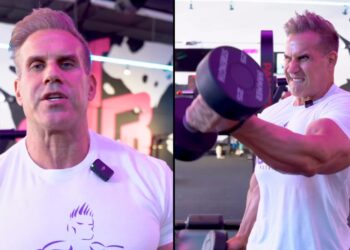Whether you are into bodybuilding, CrossFit, or calisthenics, parallel bar dips are a must-have in your exercise arsenal.
As a personal trainer, I prioritize having my clients master parallel bar dips early on in their lifting journey to establish a strong foundation.
The weighted parallel bar dips are a versatile exercise that can be used to target the triceps or chest by slightly tweaking the exercise form.
A study published in Int. J. Environ. Res. Public Health compared the muscle activation patterns of different dip variations. It concluded that parallel bar dips result in higher peak muscle activations than bench dips, indicating their effectiveness for strength and hypertrophy. (1)
You could perform the weighted parallel dips in a park on the parallel bars, a dedicated dip station in a commercial gym, or a power rack-mounted dip station in your garage gym.
In this article, we dive into everything you need to know to perfect the weighted parallel bar dips, including in-depth exercise instructions, tips, common mistakes, and progression variations.
Level Up Your Fitness: Join our 💪 strong community in Fitness Volt Newsletter. Get daily inspiration, expert-backed workouts, nutrition tips, the latest in strength sports, and the support you need to reach your goals. Subscribe for free!
How To Perform Weighted Parallel Bar Dips
Here is the step-by-step guide on how to perform weighted parallel bar dips to train your chest:
Step One — Wear a Dip Belt
Wear a dip belt so the chain side is in the front. Loop a chain with a carabiner through the belt loops and weight plate and clip it back to the loop. The belt should be tight enough so it stays in place during the exercise.
Pro Tip: Wrap the belt above your glutes so it doesn’t slide down your waist during the set.
Step Two — Take Your Position on the Bars
Position yourself between the parallel bars and grab them with a neutral grip (palms facing inward). I recommend holding the bars with a full grip (thumbs wrapped around the bar). Using a suicide grip (thumbless) can increase the risk of slippages and injury while lifting heavy.
Fully extend your elbows so your feet are off the floor. Bend your knees so your upper and lower legs are at 90 degrees. Your wrists, elbows, and shoulders should be stacked in the starting position.
Pro Tip: I recommend keeping the knees extended while targeting the triceps. It helps maintain an upright torso throughout the exercise. Bending the knees can lead to a forward torso lean.
Step Three — Slow Eccentrics
Take a deep breath and slowly lower your body toward the floor by flexing your elbows. Lean forward slightly and flare your elbows to bias the chest. Go as low as you comfortably can. Ideally, your upper arms should be parallel to the floor at the bottom of the range of motion.
Pro Tip: Avoid leaning forward too much, as it can transfer the tension from your chest to the front deltoids. Conversely, you must maintain an upright torso to target the triceps.
Step Four — Concentrics
Pause at the bottom, where you feel a deep stretch in your pecs. Then, return to the starting position by extending your elbows and breathing out sharply. Squeeze your chest at the isometric contraction point at the top.
Repeat for recommended reps.
Pro Tip: Avoid rushing through the upward movement. Keep the reps slow and controlled for optimal muscle fiber stimulation.
Tips For Performing Weighted Parallel Bar Dips
Make the most of this compound lift with these training tips:
- You could perform this exercise using a dip belt with weight plates or dumbbells attached to it, a weighted vest, a heavy backpack, or while holding a dumbbell between your ankles. Use the tools that are the most convenient for you.
- Experiment with different rep cadences for maximal muscle fiber stimulation. Studies have shown that slower eccentrics can lead to greater muscle activation, which can promote hypertrophy. (2)
- Keep your core engaged throughout the range of motion. Bracing your core helps you eliminate momentum and improve chest stimulation.
- Avoid fully locking out your elbows at the top, as it can release the tension from your chest and triceps.
- While targeting the chest, keep your torso at 45 degrees throughout the exercise. Avoid leaning forward on eccentrics and getting upright during concentrics.
Muscles Worked During Weighted Parallel Bar Dips
The weighted parallel bar dips primarily target the chest and triceps. Here is how to optimize your training for each:
Chest
The weight parallel bar dips bias the pectoralis major. Keep your torso at 45 degrees throughout the range of motion for optimal chest stimulation. Remember, leaning forward too much can transfer the tension to the anterior deltoids.
Training with weights adds to the complexity of the parallel bar dips. Feel free to readjust your setup during the exercise to ensure you are working the intended muscles.
Triceps
I highly recommend keeping your knees extended and maintaining your body in a straight line from head to toe while performing weighted parallel dips to load the triceps. Bending at the knees can naturally lead to a slight forward lean, which transfers the tension to the chest.
Folks with access to a gym dip machine should make the most of it. This machine eliminates the use of momentum, allowing you to focus on your training form.
Secondary Muscles
The weighted parallel bar dips are a compound lift, meaning they involve movement across several joints, leading to multiple muscle group engagement.
Front and rear deltoids, abs, and upper and lower back are the secondary (supporting) muscles during the weighted parallel bar dips.
Benefits of Weighted Parallel Bar Dips
These are the advantages of adding the weighted parallel bar dips to your exercise regimen:
Builds Strength and Hypertrophy
Adding weighted parallel bar dips to your training regimen can help you build strength and muscle mass. You must, however, tweak your programming according to your training objectives.
People aiming for hypertrophy should perform three to five sets of eight to 12 reps with 60 to 80 percent of their one-rep max (1RM), whereas those training for strength gains should perform three to six sets of one to five reps with 90 to 100 percent of their 1RM. (3)
That said, progressive overload is non-negotiable whether you’re training for hypertrophy or strength gains. It involves gradually increasing the weight, frequency, or number of repetitions or sets in your workouts.
Boosts Functional Strength
Weighted parallel bar dips are a compound movement involving most of your upper body joints. Performing this exercise regularly can improve your overall functionality and enhance your performance in day-to-day tasks.
Improves Lockout
Weighted parallel bar dips are especially great for people trying to build pressing strength. It involves working on your core and shoulder strength and stability, which can improve your bench press, overhead press, and clean and jerk performance.
Level Up Your Fitness: Join our 💪 strong community in Fitness Volt Newsletter. Get daily inspiration, expert-backed workouts, nutrition tips, the latest in strength sports, and the support you need to reach your goals. Subscribe for free!
This exercise can help you build a bigger bench press. However, you must scale the weighted dips conservatively and use weights you can handle comfortably without compromising form.
Versatility
Weighted parallel bar dips are a versatile exercise and can be included in chest, arm, and back workouts. Slightly tweaking the training form allows you to bias different muscle groups.
Since this exercise requires minimal equipment, you can perform it anywhere. Folks who don’t have access to parallel bars can execute this exercise on a couple of chairs, making it perfect for when you are traveling.
Finally, training for mechanical failure on weighted parallel bar dips is safer than hitting failure on other compound lifts like the bench press. That said, you shouldn’t go too heavy on this exercise as it can put unnecessary strain on the shoulder rotator cuffs.
Mistakes While Performing Weighted Parallel Bar Dips
Stay clear of the following errors to make the most of this exercise and minimize injury risk:
Not Following a Full Range of Motion
Parallel bar dips are one of those exercises that look super easy but have you begging for mercy as soon as you start your first set.
Many exercisers limit the range of motion and rush through the reps to end the suffering quickly. They, however, are leaving gains on the table by doing so.
Your upper and lower arms should be at 90 degrees at the bottom of the movement to ensure maximal muscle fiber stimulation. Experience lifters with decent shoulder mobility can dip below parallel for a deep muscle stretch.
Use a slow and controlled tempo, especially on the eccentrics, to ensure the target muscles move the weights. Ripping through the reps leads to greater secondary muscle fiber engagement.
Lifting Too Heavy
Many lifters let their egos get the better of them in the gym.
Bodyweight exercises like pull-ups, dips, and muscle-ups look badass, even more so when you do them with additional weights.
This quest for the ultimate badassery leads many people to stack more weights on the dip belt than they can handle. Not only does this lead to suboptimal muscle engagement, but also significantly increases injury risk.
Using Momentum
There are two main ways in which people use momentum in weighted parallel bar dips. Some people generate force by swinging their legs or extending their knees, while others move their torso forward and back to get out of the sticking points.
Both ways remove tension from the target muscle groups and shift it to the supporting muscles. Perform the exercise with a strict range of motion. It’s better to stop at eight reps while following a strict ROM than do 12 reps with the same weight using a lousy form.
Shrugging the Shoulders
This is one of the most common mistakes while performing parallel bar dips. Many people pull their shoulders toward their ears when they get into the starting dip position. This limits the range of motion, resulting in suboptimal muscle fiber stimulation.
Pull your shoulder blades back and down, and imagine driving them into the bars throughout the range of motion. This also ensures you don’t hunch your back during the exercise. An open chest setup will lead to greater muscle activation.
Variations of Weighted Parallel Bar Dips
Use the following weighted parallel bar dip variations to keep your workouts exciting and challenging:
L-Sit Dips
This is a progression variation to the weighted parallel bar dips. This exercise loads your core while biasing your triceps and chest. That said, this high-skill gymnastics exercise is best reserved for experienced exercisers.
Steps:
- Grab the parallel bars with a neutral grip.
- Fully extend your elbows so your legs are suspended in the air. Your body should be in a straight line.
- Brace your core and lift your legs so they are parallel to the floor.
- Slowly lower toward the floor by flexing your elbows until your upper arms are parallel to the floor.
- You should feel a deep stretch in the target muscles at the bottom of the range of motion.
- Reverse the movement to return to the starting position.
- Squeeze the chest at the top.
- Repeat for recommended reps.
Pro Tip: Pull your shoulder blades back and down to avoid hunching your back, as it can lead to the lowering of the legs.
Assisted Dips
Assisted dips are a regression weighted parallel bar dips variation. It is perfect for beginners with access to an assisted dip machine at their gym. The dip machine supports some of the user’s body weight, which makes the exercise easier.
Steps:
- Pin an appropriate weight on the dip machine.
- Step onto the side rails and grab the parallel bars with a neutral grip.
- Place one shin on the machine’s pad, followed by the other.
- Slowly lower toward the floor as far as your mobility allows.
- Pause at the bottom for an optimal stretch.
- Return to the starting position.
Pro Tip: Since the machine will take weight off the target muscles during eccentrics, you must go as slow as possible (anywhere between three to six seconds) to load the triceps maximally.
Bench Dips
Bench dips are arguably the most beginner-friendly dip variation. Since you only need an elevated platform to perform this exercise, you can do it anywhere.
Steps:
- Sit on an elevated surface like a flat bench.
- Place your hands on the bench shoulder-width apart. Extend your legs in front of you with a slight knee flexion.
- Suspend your torso in front of the bench.
- Slowly lower your butt to the floor as low as your mobility allows.
- Extend your elbows to return to the starting position.
- Pause and contract your triceps at the top.
Pro Tip: Keep your hips and torso as close to the bench as possible. Letting your torso drift away from the bench will put unnecessary strain on your shoulder rotator cuffs and remove tension from your target muscle.
FAQs
Which is the best way to add resistance to the weighted parallel bar dips?
You could add resistance by using a dip belt and weight plates, wearing a weighted vest, or holding a dumbbell between your ankles. Pick the one that feels the most convenient and comfortable. There are no right or wrong answers here.
How much weight should I lift on the weighted parallel bar dips?
The weight you use for this exercise will depend on your experience and fitness level. Beginners should start with the smallest weights and increase them gradually as they get stronger.
Remember, you should not compromise training form by trying to lift heavy. Punching above your weight class leads to suboptimal muscle stimulation and increases your injury risk significantly.
What is the ideal training volume for the weighted parallel bar dips?
Like the poundage, the training volume will depend on your training experience and objective. To bias hypertrophy, beginners can perform three sets of 8 to 12 reps of weighted parallel dips in their chest workout. Conversely, aim for three to six sets of one to five reps to build strength.
Wrapping Up
The weighted parallel bar dips are among the most underutilized upper body exercises to build strength, muscle mass, and functionality. You could perform this exercise using a dip belt, weighted vest, or while holding a dumbbell between your ankles.
Although heavier weights can lead to greater chest fiber stimulation, ensure that you don’t compromise training form trying to hit a PR. Lean forward slightly to bias the chest or keep your torso upright to target the triceps.
If you have any questions about the weighted parallel bar dips, drop them in the comments below, and I’ll be happy to help!
References
- McKenzie A, Crowley-McHattan Z, Meir R, Whitting J, Volschenk W. Bench, Bar, and Ring Dips: Do Kinematics and Muscle Activity Differ? Int J Environ Res Public Health. 2022 Oct 14;19(20):13211. doi: 10.3390/ijerph192013211. PMID: 36293792; PMCID: PMC9603242.
- Douglas J, Pearson S, Ross A, McGuigan M. Chronic Adaptations to Eccentric Training: A Systematic Review. Sports Med. 2017 May;47(5):917-941. doi: 10.1007/s40279-016-0628-4. PMID: 27647157.
- Schoenfeld, B. J., Grgic, J., Van Every, D. W., & Plotkin, D. L. (2021). Loading Recommendations for Muscle Strength, Hypertrophy, and Local Endurance: A Re-Examination of the Repetition Continuum. Sports, 9(2).
Interested in measuring your progress? Check out our strength standards for Bench Press, Muscle Ups, Pull Ups, and more.








